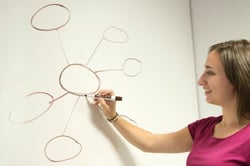With this quarterly planning season coming to a close, I've discussed hundreds of priorities in the last few weeks with clients - you are a focused and busy bunch! So many of those priorities represented projects. You are designing new products, finalizing new employee & client programs and documenting processes. Each project has its own specific purpose and many times, it spans across multiple departments. So, when it comes time to execute, how do you all get aligned?
weeks with clients - you are a focused and busy bunch! So many of those priorities represented projects. You are designing new products, finalizing new employee & client programs and documenting processes. Each project has its own specific purpose and many times, it spans across multiple departments. So, when it comes time to execute, how do you all get aligned?
A great place to start is by creating an Objective Statement together.
An Objective Statement is a simple tool that provides a framework and guidelines for a specific project, product, idea, initiative or decision. The purpose of creating an Objective Statement is to ensure that everyone is aligned around the purpose, scope and expectations.
Here is the simple framework:
TO: (What is the action? What are you going to do? Start with a verb.)
IN A WAY THAT: (How will you go about doing it? List criteria, scope, involvement, success measures, specific tactics, side benefits, or any other relevant information.)
SO THAT: (Why are you doing this? Why is it important? What is the one main benefit?)
And, here's an example:
TO: Create an Employee Referral program
IN A WAY THAT: Improves the quality of applicants (more A players); strengthens our culture; benefits our current employees; is simple for the HR team to administer; doesn't create drama; helps us avoid mis-hires
SO THAT: We hire the right people, the first time, ultimately impacting our retention of A players and our Employee NPS
2 tips when creating an Objective Statement:
- Start with the “TO” and make sure it is specific and actionable.
- To avoid getting bogged down in the “IN A WAY THAT” section, agree on and fill in the “SO THAT” section next. Getting the team clear about the main benefit and common purpose of the objective will help clarify some of the specifics you’ll want to include in the “IN A WAY THAT” section.
If you begin with the end in mind, the outcome should be aligned across the organization. This speeds up your execution in the long run. With shared expectations at the outset, it's rare to need to go "back to the drawing board" on your project.




